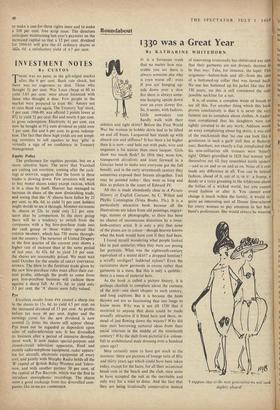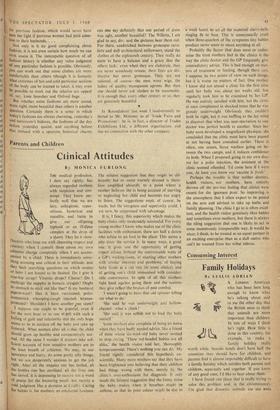Roundabout
1330 was a Great Year
By KATHARINE WHITEHORN
IT is a fortunate truth that no matter how mis- erable you are there is always someone else who is even worse off : even if you are hanging up- side down over a slow fire there is always some- one hanging upside down over an even slower fire. So, it seems, with fashion. Girls nowadays can hardly walk with their stilettos and tight skirts? Before the First World War the women in hobble skirts had to be lifted on and off buses. Lacquered hair stands up with absurd size and stiffness? It has been a lot higher than it is now—and held out with pads, wire and unguents a lot nastier than mere lacquer. Girls show too much flesh? In 1816 they wore low, transparent decolletes and leant forward in a Grecian bend to make sure everyone got the full benefit; and in the early seventeenth century they sometimes exposed their breasts altogether. Toei may be pointed today : they were as long and thin as pokers in the court of Edward IV.
All this is made abundantly clear in A Picture History of English Costume, by C. Willett and Phyllis Cunnington (Vista Books, 35s.). It is a particularly attractive book because all the illustrations are taken from old paintings, engrav- ings, statues or photographs; so there has been no chance of unconscious distortion by a twen- tieth-century artist. It is only a pity that none of the plates are in colour—though heaven knows what the book would have cost if they had been.
I found myself wondering what people looked like in past centuries when they were not posing for portraits. What was the eighteenth-century equivalent of a seated skirt? a dropped hemline? a scruffy cardigan? laddered nylons? Even the caricatures show garments in excess rather than garments in a mess. But this is only a quibble: there is a mass of material here.
As the book is called a picture history, it is perhaps churlish to complain about the curtness of the text—one short chapter to each century, and long captions. But it is because the hints thrown out are so fascinating that one longs to know more. Why was it not till 1330 that it occurred to anyone that dress could be made sexually attractive if it fitted here and there, in- stead of just flowing down the wearer? Why did men start borrowing sartorial ideas from their social inferiors in the middle of the nineteenth century? Why the shift from pictorial (i.e. colour- ful) to architectural male dressing over a hundred years ago?
Men certainly seem to have got stuck at the moment: there are pictures of lounge suits of fifty and thirty years ago which could have been taken today, except for the faces; for all their occasional break-outs at the beach and the club, men seem to have accepted the suit as the inevitable and only way for a man to dress. And the fact that they are being irrationally conservative instead of innovating irrationally has obliterated any idea that their garments are not divinely decreed to be that way. Take, for instance, the lapel. This originates—button-hole and all—from the idea of a buttoned-up collar that was turned back. No one has buttoned up his jacket like this for 130 years; yet this is still considered the only possible neckline for a suit.
It is, of course, a complete waste of breath to say all this. For another thing which this book proves conclusively is that it is never the veil faintest use to complain about clothes. A trades- man complained that his daughters were too tightly corseted to do any work; Addison wrote an essay complaining about big skirts; it was said of the mackintosh that `no one can look like a gentleman in such a garb' (tell that at Badmin- ton); Bentham, not exactly a fop, complained that his non-utilitarian silk trousers were `bitterly tight.' Others grumbled in 1828 that women 'pad, themselves out till they resembled bottle spiders' —and so on and so on and so on. None of it ever made any difference at all. You can be behind fashion, ahead of it, out of it, in it : a frump, a dandy'or a voice groaning in the wilderness about the follies of a wicked world; but you cannot avoid fashion or alter it. You cannot even change it much within the family; it would re- quire an interesting sort of Dunne time-scheme for every woman to pay attention to her hus- band's preferences. She would always be wearing 'I suppose that to the next generation we will wok slightly absurd.' the previous fashion, which would never have seen the light if previous women had paid atten- tion to their husbands. . .
Not only is it no good complaining about fashion; it is not even certain how much we can even assess it. The inescapable question of all fashion history is whether any value judgment of any particular fashion is possible. Obviously, You can work out that some clothes are more comfortable than others (though it is fantastic what extremes of hot and cold particular sections of the body can be trained to take); it may even be possible to work out the relative sex appeal of, say, knee breeches and Oxford bags.
But whether some fashions are more sound, More right, more beautiful than others is another question. Certainly there is a sense in which today's fashions are always charming. yesterday's and tomorrow's hideous, the fashions of the day before yesterday quaint, and anything before that imbued with a spurious historical charm; can one say definitely that one period of dress was ugly, another beautiful? The Willetts, 1 am glad to say, do: and the pictures bear them out. For there, sandwiched between grotesque cava- liers and dull architectural millowners, stand the clothes of the eighteenth century. They really do seem to have a balance and a grace that the others lack: even when they are elaborate, they are never senselessly ornate; their lines are dis- tinctive but never grotesque. They arc.. not rational, of course—the men wore wigs, the ladies of quality 'transparent aprons. But then one should never ask clothes to be reasonable. It is enough that, every other century or so, they are genuinely beautiful.
ylr• In 'Roundabout' last week I inadvertently re- ferred to Mr. Moloney as of 'Trade Fairs and Promotions': he is. in fact, a director of Trades Exhibitions Lid.. a different organisation, and has no connection with the other company.



























































 Previous page
Previous page